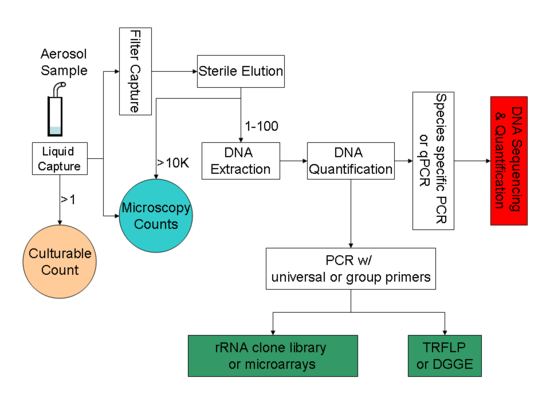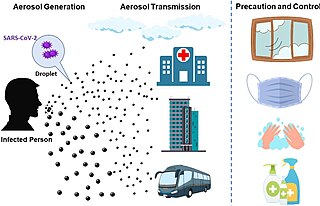Sampling and detection methods
Bioaerosol sampling techniques
To enable subsequent identification and quantification, bioaerosols need to be captured from the air first. Different air sampling techniques have been used to realise the goal of capturing indoor bioaerosols.. Important characteristics of bioaerosol sampling include: representativeness of sampling, sampler performance, and compatibility with subsequent analysis. [27] Long-term sampler theoretically has a better representativeness of sampling than short-term sampler, but may not have a good temporary resolution. Performance of samplers (i.e., limit of detection and upper limit of range) has a significant impact on the reliability of results. [27] Different characterisations of samplers can also limit the possibilities for further analysis (identification and quantification). Major bioaerosol sampler types and their possible subsequent analysis are summarised in Table 1. A frequently used sampler in previous studies is the Andersen impactor. [3] [11] [28]
| Sampler | Example of Device | Possible Subsequent Analysis |
|---|---|---|
| Impactors and Sieve Samplers | Andersen impactor; SAS; Burkard sampler | Cultivation; Microscopic analysis |
| Impingers | AGI-30; Shipe sampler; Midget, multi-stage and micro-impingers | Cultivation; Microscopic analysis; Biochemical analysis; Immunoassays |
| Centrifugal Samplers | RCS; Aerojet cyclone | Cultivation; Microscopic analysis; Biochemical analysis; Immunoassays |
| Filter Cassette | Glass fiber; Teflon filters; Polycarbonate | Cultivation; Microscopic analysis; Biochemical analysis; Immunoassays |
Certain limitations exist for commonly used bioaerosol samplers. For most of the samplers, nonbiological environmental particles such as dust must be separated from bioaerosols prior to detection. [29] The diluted nature of bioaerosol in the air also poses challenges to samplers. While total microorganism concentrations are on the order of 106/cm3 or greater, bioaerosol concentrations are commonly less than 1/cm3, and often less than 1/m3 in the case of infectious aerosols. [5] Moreover, many commercially available bioaerosol samplers haven not been investigated on their collection efficiencies for particles with different aerodynamic diameters, which makes it impossible to get the size-resolved bioaerosol information. [5]
Identification and quantification methods
In previous research on indoor bioaerosol in residential environments, microorganisms have been quantified by conventional culture-based techniques, in which colony forming units (CFU) on selective media are counted. [30] Cultivating methods have several disadvantages. Culture-based methods are known to underestimate environmental microbial diversity, based on the fact that only a small percentage of microbes can be cultivated in the laboratory. This underestimation is likely to be signified for the quantification of bioaerosol, since colony counts of airborne microbes are typically quite different from direct counts. [31] Culture-based methods also need relatively long incubation times (over 24 hours) and are labor-intensive. [29] Consequently, culture-based methods are no longer suitable for effective and rapid identification and quantification of bioaerosol, [29] and non-culture based methods, such as immunoassays, molecular biological tests, and optical, and electrical methods, have been developing over the past few decades. [29]
Major culture-independent identification/quantification methods adopted in previous bioaerosol studies include polymerase chain reaction (PCR), [17] quantitative polymerase chain reaction (qPCR), [32] microarray (PhyloChip), [33] fluorescent in situ hybridisation (FISH), [34] flow cytometry [34] and solid-phase cytometry, [18] immunoassay (i.e., enzyme-linked immunosorbent assay (ELISA)). [28] The well-known PCR is a powerful tool in identifying and even quantifying the biological origin of bioaerosols. PCR alone cannot accomplish all the tasks related to bioaerosol detection; instead it usually serves as the preparation tool for subsequent processes like DNA sequencing, microarray, and community fingerprinting techniques. A typical procedure for PCR-based bioaerosol analysis is shown in Figure 1.

Molecular biological methods for bioaerosol are significantly faster and more sensitive than conventional culture-based methods, and they are also able to reveal a larger diversity of microbes. Targeting the variation in the 16S rRNA gene, a microarray (PhyloChip) was used to conduct comprehensive identification of both bacterial and archaeal organisms in bioaerosols. [33] New U.S. EPA methods have been developed to utilise qPCR to characterise indoor environment for fungal spores. [5] In a study by Lange et al., [34] FISH method successfully identified eubacteria in samples of complex native bioaerosols in swine barns. Nonetheless, molecular biological tools have limitations. Since PCR methods target DNA, viability of cells could not be confirmed in some cases. [18] When qPCR technique is used for bioaerosol detection, standard curves need to be developed to calibrate final results. One study indicated that "curves used for quantification by qPCR needs to be prepared using the same environmental matrix and procedures as handling of the environmental sample in question" and that "reliance on the standard curves generated with cultured bacterial suspension (a traditional approach) may lead to substantial underestimation of microorganism quantities in environmental samples". [32] Microarray techniques also face the challenge of natural sequence diversity and potential cross-hybridisation in complex environmental bioaerosols). [33]












